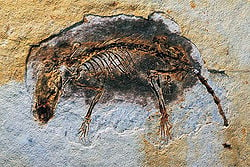Eutheria
| Eutherians
|
|---|
 Fossil specimen of Eomaia scansoria, an early eutherian
|
| Scientific classification |
|
|
|
Eutheria (from Greek ευ-, eu- "true/good" and θηρίον, thērion "beast" hence "true beasts") is one of two mammalian clades with extant members that diverged in the Early Cretaceous or perhaps the Late Jurassic. The other is the Metatheria, which includes marsupials, most of whom accommodate their neonates in pouches. Except for the Virginia opossum, which is a metatherian, all mammals indigenous to Europe, Africa, Asia, and North America north of Mexico are eutherians. Extant eutherians, their last common ancestor, and all extinct descendants of that ancestor are placentals, in the group Placentalia.
Kingdom: Animalia Phylum: Chordata Class: Mammalia Sublegion: Zatheria Infralegion: Tribosphenida Subclass: Theria Clade: Eutheria Huxley, 1880
Eutherians are distinguished from noneutherians by various features of the feet, ankles, jaws and teeth. One of the major differences between placental and nonplacental eutherians is that placentals lack epipubic bones, which are present in all other fossil and living mammals (marsupials and monotremes).
The oldest known eutherian species is Juramaia sinensis, dated at from the Jurassic in China.[2]
The name "Eutheria" was introduced by Thomas Henry Huxley in 1880, meant to encompass a more broadly defined group than Placentalia.
Characteristics
The features of Eutheria that distinguish them from metatherians, a group that includes modern marsupials, are:
- an enlarged malleolus ("little hammer") at the bottom of the tibia, the larger of the two shin bones.[3]
- the joint between the first metatarsal bone and the entocuneiform bone in the foot is offset further back than the joint between the second metatarsal and middle cuneiform bones – in metatherians these joints are level with each other.[3]
- various features of jaws and teeth.[3]
Evolutionary history
Eutheria contains several extinct genera and larger groups, many with complicated taxonomic history that is still unresolved. Members of the Adapisoriculidae, Cimolesta and Leptictida have been previously placed within the out-dated placental group "Insectivora", while Zhelestids have been considered primitive ungulates.[4] However, more recent studies have suggested these enigmatic taxa represent stem group eutherians, more basal to Placentalia.[5][6]
| The fossil eutherian species believed to be the oldest known is Juramaia sinensis, which lived about .[2] Montanalestes was found in North America, while all other nonplacental eutherian fossils have been found in Asia. The earliest known placental fossils have also been found in Asia.[3] | |
† = extinct |
ReferencesISBN links support NWE through referral fees
- ↑ Rook, Deborah L. and Hunter, John P. (April 2013). Rooting Around the Eutherian Family Tree: the Origin and Relations of the Taeniodonta. Journal of Mammalian Evolution: 1–17.
- ↑ 2.0 2.1 Luo, Z. and C. Yuan, Q. Meng, and Q. Ji (2011). A Jurassic eutherian mammal and divergence of marsupials and placentals. Nature 476 (7361): 42–45.
- ↑ 3.0 3.1 3.2 3.3 3.4 Ji, Q., Luo, Z-X., Yuan, C-X.,Wible, J.R., Zhang, J-P. and Georgi, J.A. (April 2002). The earliest known eutherian mammal. Nature 416 (6883): 816–822.
- ↑ Rose, Kenneth D. (2006). The beginning of the age of mammals. Baltimore: Johns Hopkins University Press. ISBN 9780801892219.
- ↑ Wible, J. R. and Rougier, G. W.; Novacek, M. J.; Asher, R. J. (2007). Cretaceous eutherians and Laurasian origin for placental mammals near the K/T boundary. Nature 447 (7147): 1003–1006.
- ↑ Wible, John R. and Rougier, Guillermo W.; Novacek, Michael J.; Asher, Robert J. (2009). The Eutherian Mammal Maelestes gobiensis from the Late Cretaceous of Mongolia and the phylogeny of cretaceous eutheria. Bulletin of the American Museum of Natural History 327: 1–123.
| Mammals |
|---|
| Monotremata (platypus, echidnas) |
|
Marsupialia: | Paucituberculata (shrew opossums) | Didelphimorphia (opossums) | Microbiotheria | Notoryctemorphia (marsupial moles) | Dasyuromorphia (quolls and dunnarts) | Peramelemorphia (bilbies, bandicoots) | Diprotodontia (kangaroos and relatives) |
|
Placentalia: Cingulata (armadillos) | Pilosa (anteaters, sloths) | Afrosoricida (tenrecs, golden moles) | Macroscelidea (elephant shrews) | Tubulidentata (aardvark) | Hyracoidea (hyraxes) | Proboscidea (elephants) | Sirenia (dugongs, manatees) | Soricomorpha (shrews, moles) | Erinaceomorpha (hedgehogs and relatives) Chiroptera (bats) | Pholidota (pangolins)| Carnivora | Perissodactyla (odd-toed ungulates) | Artiodactyla (even-toed ungulates) | Cetacea (whales, dolphins) | Rodentia (rodents) | Lagomorpha (rabbits and relatives) | Scandentia (treeshrews) | Dermoptera (colugos) | Primates | |
Credits
New World Encyclopedia writers and editors rewrote and completed the Wikipedia article in accordance with New World Encyclopedia standards. This article abides by terms of the Creative Commons CC-by-sa 3.0 License (CC-by-sa), which may be used and disseminated with proper attribution. Credit is due under the terms of this license that can reference both the New World Encyclopedia contributors and the selfless volunteer contributors of the Wikimedia Foundation. To cite this article click here for a list of acceptable citing formats.The history of earlier contributions by wikipedians is accessible to researchers here:
The history of this article since it was imported to New World Encyclopedia:
Note: Some restrictions may apply to use of individual images which are separately licensed.

